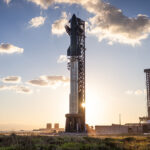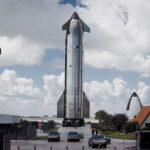SpaceX expanded the range and speed of its tests since we last reported the mounting of Booster 9 on the Starship OLM more than a week ago.
In the first Starship flight test, the base of the Orbital Launch Mount (OLM) was significantly damaged due to the thrust impact and heat of Super Heavy Raptor engines. This event also scorched the water deluge system under the base.
Super Heavy Booster 9 went through a propellant load test. While SpaceX performed a cryogenic pressure-proof test on Starship 28.
Starship OLM Water Deluge System Test
It took months to repair the OLM. SpaceX redesigned and upgraded the water deluge system as well during this phase. This new and enhanced Starship deluge system was tested on Friday.
SpaceX CEO Elon Musk posted the following short video of the Starship water deluge system test on his social media platform X (formerly Twitter).
“New water deluge system to protect against the immense heat & force of Starship launch,” Elon Musk tweeted the reason for the development and testing of this new system.
This system can be called a “rocket flame deflector system” as well. It will help deflect the flames and protect OLM from getting damaged such as the one we saw after the 1st Starship orbital launch attempt.
However, the new water deluge system was tested while Booster 9 was mounted on the OLM and the engines were turned off. This system will demonstrate its reliability only when it’s used during the launch as Raptor engines ignite at their full thrust potential.
The following video that Elon Musk posted has no sound. SpaceX removed the sound probably because a very loud noise was heard during the test (video with sound by NASASpaceFlight below).
This deafening sound is not produced by the water release under the OLM, it is coming from the tank farm that releases a large amount of nitrogen during the test.
Booster 9 Propellant Load / Cryo Test
SpaceX performed a propellant load/cryo test on Booster 9 as it was fully loaded with liquid oxygen (LOX) and nitrogen. This test determines the rocket booster’s capacity to withstand the propellant pressure before it embarks on a live mission.
In the live test recording video by NASASpaceFlight below, we see a super-cold liquid oxygen frost line appearing first at the bottom of Booster 9 and going upwards as the rocket is filled with cryogenic propellant.
In a real flight, methane is loaded with liquid oxygen — also called Methalox in short by the SpaceX community.
Interestingly, after the Booster 9 cryogenic test, a meteor was also seen at Starbase in the evening. Hint: You can find the meteor around the middle of the following video (blink and you’ll miss it).
SpaceX is performing these tests rapidly one after the other in preparation for the 2nd Starship orbital flight test. Starship 25 already went through a 6-engine static fire test in June. The next major milestone will be a Booster 9 33-engine static fire test on the road to the next Starship flight attempt.
Stay tuned for future updates on Starship and SpaceX, Follow us on:
Google News | X (Twitter) | Flipboard | WhatsApp Channel | RSS (Feedly).
Related
- SpaceX shares stunning videos of Flight 11 Starship and Booster 15 landings
- Starship Flight 11: Read live updates, watch live-stream recordings of the launch
- Starship Flight 11: Here’s how to watch the live-streams and get live updates
- SpaceX finalizes preps for Starship Flight 11 launch on 13th October (updates, video)
- SpaceX announces Starship Flight 11 date, launch preparations update from Starbase
- Flight 11 Ship 38 goes through a full duration static fire test, the last Block 2 Starship








